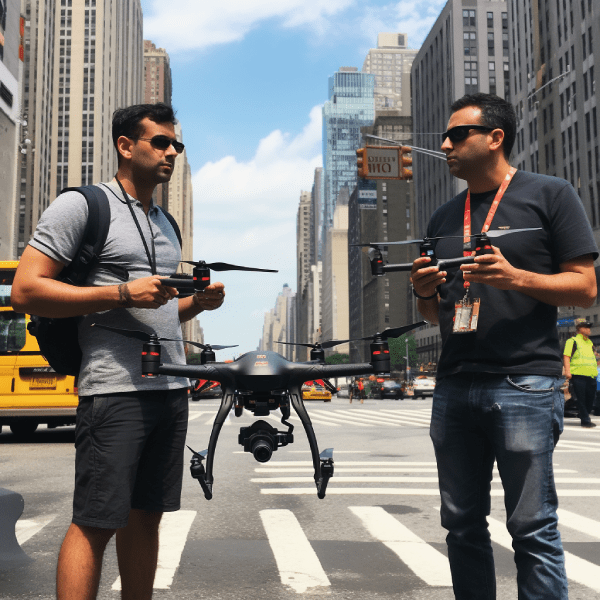Introduction
Urban Air Mobility (UAM) is the use of drones or other aircraft for transportation within urban areas. UAM has the potential to revolutionize the way people and goods are transported, offering a sustainable and efficient alternative to traditional transportation methods. However, the UAM industry also faces significant technological and regulatory challenges that must be addressed for widespread adoption.
In this blog post, we will explore the UAM industry’s sustainability, technological challenges, and regulatory landscape. Additionally, we will discuss the hottest trends in the drone industry, including advancements in technology and the emergence of new use cases.
Sustainability in the UAM industry
The use of UAM offers significant sustainability benefits. UAM can transport people and goods quickly and efficiently, reducing the number of vehicles on the road and thus reducing carbon emissions. Furthermore, UAM can reduce traffic congestion, which is a major source of pollution. By flying over congested roads, UAM can transport people and goods quickly and efficiently, without adding to the congestion.
In addition to reducing carbon emissions, UAM can also reduce noise pollution, which is a major source of public health problems in urban areas. By using electrically powered aircraft, UAM can significantly reduce noise pollution in urban areas, contributing to a more sustainable and livable environment.
Technological challenges in the UAM industry
The UAM industry faces significant technological challenges that must be addressed for widespread adoption. Below are some of the most significant technological challenges facing the UAM industry:
- Battery technology: Battery technology is a major limiting factor for the UAM industry. The range and flight time of electric aircraft are currently limited by the available battery technology. Advancements in battery technology are essential for the widespread adoption of UAM.
- Air traffic management: The integration of UAM into existing air traffic management systems poses significant technical challenges. New air traffic management systems must be developed to ensure the safe and efficient operation of UAM.
- Autonomy: Autonomous UAM has the potential to revolutionize the transportation industry, but significant advancements in artificial intelligence and machine learning are necessary for the safe and reliable operation of autonomous aircraft.
- Infrastructure: The development of UAM infrastructure, including urban airports and charging stations, is necessary for the widespread adoption of UAM. The development of this infrastructure will require significant investment and coordination between public and private entities.
Regulatory landscape in the UAM industry
The UAM industry also faces significant regulatory challenges, particularly in the US and EU. Safety and privacy concerns have led to strict regulations that restrict the use of UAM for transportation.
In the US, the Federal Aviation Administration (FAA) has established regulations for the use of UAM for commercial purposes. According to these regulations, UAM must be flown within the operator’s line of sight and cannot fly over people, among other restrictions. Furthermore, the FAA requires commercial UAM operators to obtain a Remote Pilot Certificate, which requires passing an aeronautical knowledge test.
In the EU, the European Aviation Safety Agency (EASA) has established regulations for the use of UAM for commercial purposes. According to these regulations, UAM must be flown within the operator’s visual line of sight, and UAM operators must obtain a remote pilot license and follow specific operational procedures.
Hottest trends in the drone industry
The UAM industry is rapidly evolving, with advancements in technology and the emergence of new use cases. Below are some of the hottest trends in the drone industry:
- Passenger drones: Passenger drones have the potential to transform the way people are transported, particularly in urban areas. These drones can transport people quickly and efficiently, reducing traffic congestion and carbon emissions.
- Delivery drones: Delivery drones have the potential to revolutionize the way goods are delivered, particularly in urban areas. Delivery drones can transport goods quickly and efficiently, reducing traffic congestion and carbon emissions.
- Urban airports: Urban airports refer to the development of airports within urban areas, allowing for the efficient and safe operation of UAM. Urban airports can significantly reduce the time and cost of transportation in urban areas, contributing to a more sustainable and livable environment.
- Artificial Intelligence (AI): AI technology is rapidly advancing, enabling drones to operate autonomously without human intervention. AI can help drones to navigate and avoid obstacles, recognize objects, and make decisions based on real-time data.
- Drone swarms: Drone swarms refer to the coordinated operation of multiple drones to accomplish a specific task. Drone swarms have a wide range of applications, from delivering packages to disaster response and search and rescue operations.
Conclusion
The UAM industry offers significant sustainability benefits, including reduced carbon emissions, traffic congestion, and noise pollution. However, the industry faces significant technological and regulatory challenges that must be addressed for widespread adoption.
Advancements in battery technology, air traffic management, autonomy, and infrastructure development are necessary for the safe and efficient operation of UAM. The regulatory landscape in the US and EU also poses significant challenges, particularly regarding safety and privacy concerns.
Despite these challenges, the drone industry is rapidly evolving, with advancements in technology and the emergence of new use cases. As technology continues to advance, it is likely that UAM will play an increasingly important role in the transportation industry, offering a sustainable and efficient alternative to traditional transportation methods.
How passenger and delivery drones are contributing to sustainability
- NASA has developed an electrically powered passenger drone prototype called the Puffin. The Puffin can transport one person and has a range of up to 50 kilometers. According to NASA, the Puffin has the potential to significantly reduce carbon emissions and energy consumption in urban areas.
- Amazon Prime Air is a delivery drone service developed by Amazon. Prime Air aims to deliver packages to customers in 30 minutes or less using small, electrically powered drones. According to Amazon, Prime Air will significantly reduce the company’s carbon footprint and energy consumption by reducing the number of delivery trucks on the road.
- UPS has partnered with the drone manufacturer Matternet to launch a drone delivery service in North Carolina. The service uses electrically powered drones to transport medical supplies between hospitals, reducing the need for ground transportation and thus reducing carbon emissions.
- Uber Elevate is a project developed by Uber to create an air taxi service using electrically powered passenger drones. According to Uber, its air taxi service has the potential to significantly reduce traffic congestion and carbon emissions in urban areas.
- DHL, a global logistics company, has launched a drone delivery service in China. The service uses electrically powered drones to deliver packages to remote and hard-to-reach areas, reducing the need for ground transportation and thus reducing carbon emissions.
- Wing is a drone delivery service developed by Google’s parent company, Alphabet. Wing uses electrically powered drones to deliver packages to customers in Virginia and Canberra, Australia. According to Wing, its drone delivery service reduces the number of delivery trucks on the road, reducing carbon emissions and traffic congestion.
- EHang is a Chinese drone manufacturer that has developed passenger drones for use in urban areas. EHang’s passenger drones are electrically powered and have a range of up to 35 kilometers. According to EHang, its passenger drones can significantly reduce traffic congestion and carbon emissions by transporting people quickly and efficiently.
- Volocopter is a German drone manufacturer that has developed electrically powered passenger drones for use in urban areas. Volocopter’s passenger drones have a range of up to 35 kilometers and can transport two people. According to Volocopter, its passenger drones have the potential to significantly reduce traffic congestion and carbon emissions.
- JD.com, a Chinese e-commerce company, has launched a drone delivery service that can transport packages up to 30 kilograms. According to JD.com, its drone delivery service has reduced the company’s carbon emissions by 25% compared to traditional delivery methods.
- Lilium is a German drone manufacturer that has developed an electrically powered passenger drone capable of vertical takeoff and landing. The drone can transport up to five passengers and has a range of up to 300 kilometers. According to Lilium, its passenger drone has the potential to significantly reduce traffic congestion and carbon emissions in urban areas.
Overall, passenger and delivery drones offer significant sustainability benefits, reducing carbon emissions, traffic congestion, and energy consumption. As drone technology continues to advance, it is likely that drone delivery and passenger services will become increasingly important in the transportation industry.



